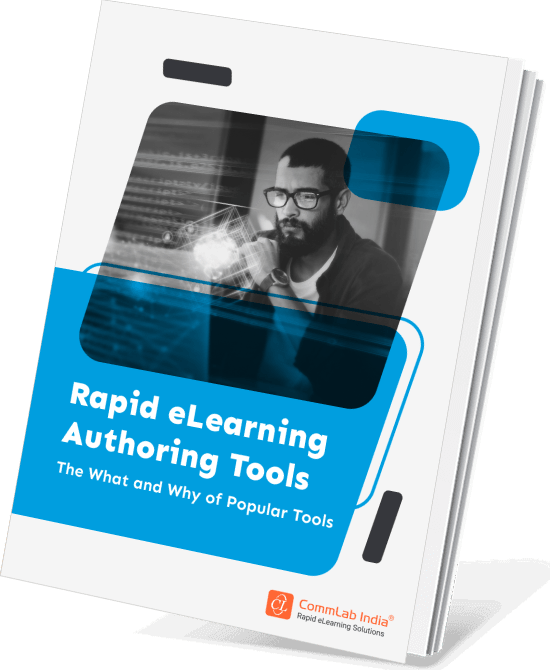Leverage the Benefits of Rapid Authoring Tools

Ever wished for a magic wand that could make the development of e-learning courses a breeze? Well, rapid authoring tools could be the answer considering the benefits they offer to the process of e-learning development. Compared to courses created using the old authoring tools- Flash, Dreamweaver, XML/HTML and JavaScript which are called legacy tools, rapid authoring tools have an edge here is a comparison of their features:
| Feature | Rapid authoring tools | Legacy authoring tools |
| Mobile compatible | Yes | No |
| Translation of courses | Easy | Tedious |
| Updating of courses | Easy | Tedious |
As the table indicates, rapid authoring tools are the versatile solution to e-learning design and delivery efforts which are making more learning companies adopt them.
→ Download eBook Now: Rapid eLearning Authoring Tools
Let’s take a quick look at what they offer:
Save time and cost:
Rapid authoring tools reduce the cost and time involved in developing e-learning courses. According to a research by Forrester for Adobe, nearly 58% of learning professionals cite the need to develop content quickly as the reason for adopting rapid authoring tools in the course development process.
As their eponymous name suggests, these tools are, well, ‘rapid’ which facilitates the creation of courses within weeks, rather than months. In the world of business, speed is of essence and these tools help create courses on time.
Rapid authoring tools include e-learning templates, default interfaces, and media elements that make creating courses easy and fast. These tools enable companies create training materials without the development overheads they would incur if they hired experts such as graphic designers and programmers.
They help develop custom courses matching the needs of the organization which cuts down the costs of maintenance and up gradation of course content. For instance this table gives the time taken to develop half an hour and one-hour course using Articulate Storyline.

These tools have a number of user-friendly features:
- Menu, Transcript, Progress Bar, Audio Control, and ability to modify colors.
- Allows for courses to be built in tighter timescales.
- Aids in the timely delivery of courses in situations where the use of traditional authoring tools would have extended the development time.
Help develop highly interactive courses:
Earlier, rapid authoring tools with their limitations were just used for converting PowerPoint presentations to e-learning courses but now with advanced features, they are being used to develop highly interactive courses.
It is possible to create engaging and immersive courses using these tools. They offer a wide range of templates, objects, and themes with drag and drop and match options which instructional designers can choose according to the design strategy they have in mind. These tools provide user-friendly interfaces and intuitive platforms for creating multimedia courses quickly. Videos and audio elements can be incorporated in the course. Scenarios and simulations and interactive drag and drop slides are options that can help create engaging courses.

Rapid eLearning Authoring Tools
Explore the What and the Why of Popular Rapid eLearning Development Tools, and GenAI Tools
- Categories of eLearning Authoring Tools
- Considerations to Choose Your Next Authoring Tool
- Features of Popular Rapid Authoring Tools
- GenAI Tools to Create Content, Graphics, Audio, and Video
Game-based courses can be developed quickly using Articulate Storyline. The in-built GUI in this tool makes it easy to choose the graphics. The built-in character packs available help create graphically rich courses.
Translation feasibility:
Translation into multiple languages with minimum effort and time is possible with rapid authoring tools. Articulate Storyline, Adobe Captivate, and Lectora Inspire help translate courses quickly and effectively. You can export the course content into a MS-Word XML document with just a click. Then these documents are sent to the translator; and once translated, they can be imported into the course with yet another click.
Transform existing courses into e-learning format:
Old learning materials in a digital format can be converted to e-learning courses. These tools can bring old courses up to date. Interactive scenarios need not be redesigned but can simply be modified and uploaded to an e-learning platform using these tools. Every presentation, image, and slide can be repurposed for e-learning, this reduces the development costs of existing learning materials.
Easy updating:
Courses can be easily and quickly updated using these tools. This feature is useful for IT consultancies that implement systems requiring regular updates and system changes. These tools can aid the quick development of courses for training in the new versions and their implementation. Rapid authoring tools make it easy to update courses on product training for sales personnel when new products are introduced. Compliance training courses can be updated with the latest information using these tools.
Easy to publish on a wide range of platforms:
These tools help you publish online courses on different platforms. CD, Desktop, SCORM and Non-SCORM are some platforms courses can be published on without using any additional plug-ins.
Using these tools, courses can be deployed on a wide range of devices from desktops, laptops, to iPads and mobile phones. These tools can publish courses to HTML5 which is used for developing mobile-compatible courses.
Speed and reduction in cost are the major drivers for organizations to adopt these tools. They reduce the time spent in e-learning development and help stay on track of the project schedule. Not just these, rapid authoring tools provide a list of benefits. If you have more to share, let us know.





